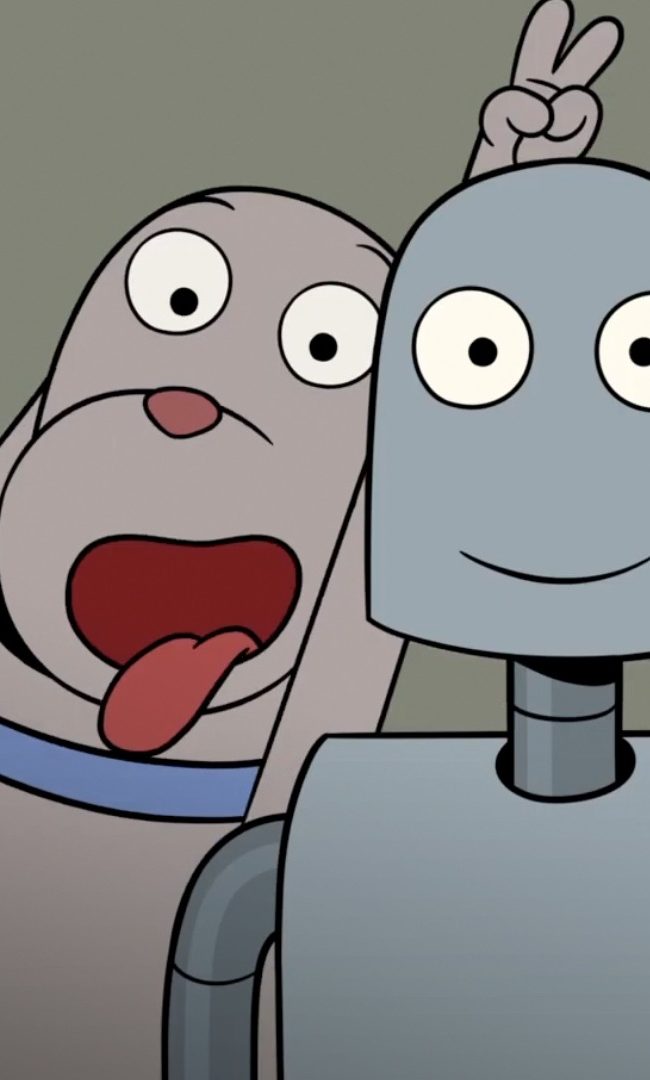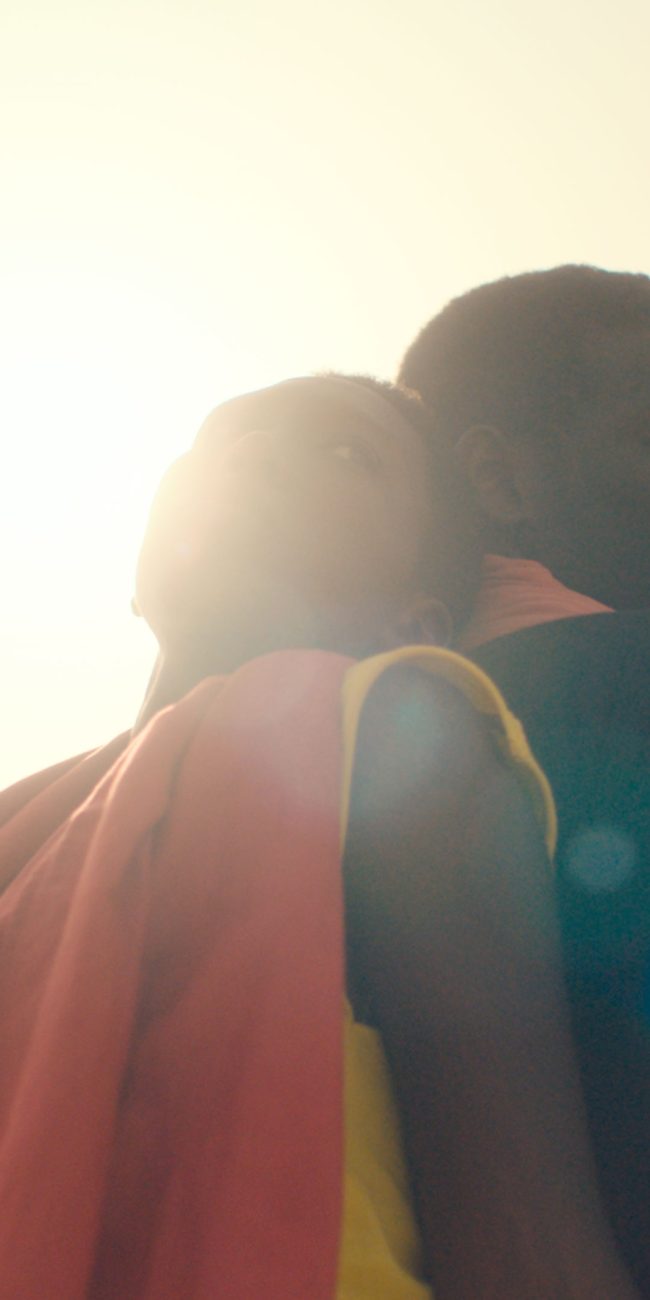A Conversation with Grímur Hákonarson & Arndís Hrönn Egilsdóttir (THE COUNTY)
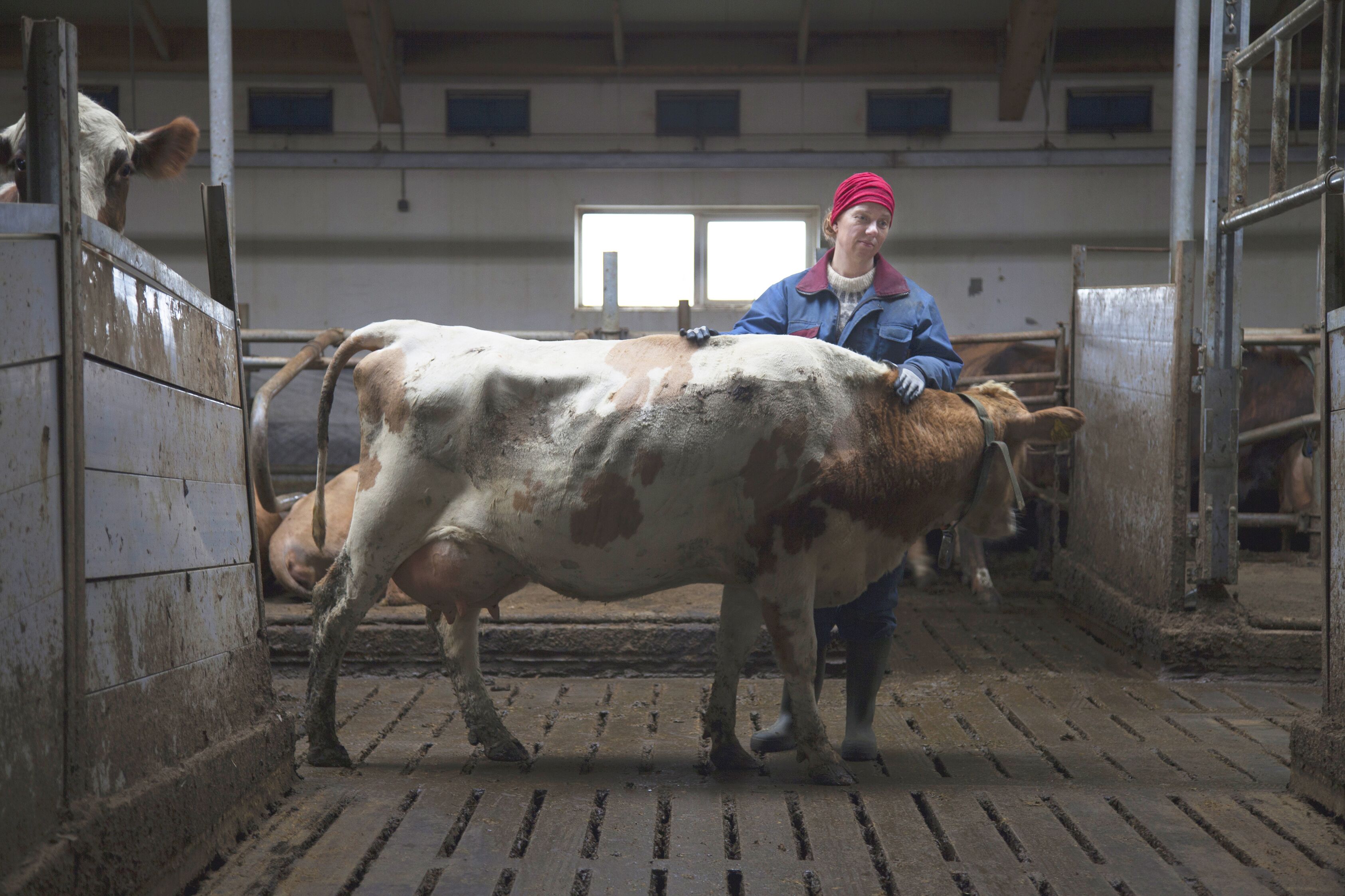
I met with Icelandic director Grímur Hákonarson (Rams) on Sunday, September 8, 2019, at the Toronto International Film Festival, to discuss his new film, The County (which I also reviewed). Lead actress Arndís Hrönn Egilsdóttir joined us a for a spirited conversation, with Swiss film critic Matthias Lerf and I each asking questions in turn. The movie follows Egilsdóttir’s Inga as she struggles to maintain her farm in the face of pressure from the regional agricultural cooperative, which forces locals to buy equipment and food from them. It’s all in the name of keeping business close to home, but it is still effectively a monopoly. When Inga decides to push back, all hell breaks loose. Here is a condensed digest of our conversation, edited for length and clarity.
Matthias Lerf: So, the last time we saw you with sheep, and now you do cows.
Grímur Hákonarson: Yes! I’m an opportunist. (everyone laughs)
ML: Do you have a country background?
GH: Yes, as a matter of fact. My parents grew up on a farm, so I spent some time, when I was a kid, on my grandfather’s farm. So, I have a little bit of experience with the farming life, and a good sense of people and characters. But my next movie is going to be in the city. Rams, you know, was about the connection between farmers and animals, but The County is a little bit different. Inga’s not like a happy farmer.
Hammer to Nail: Recently, a number of Icelandic films have received major international distribution, so I’ve seen quite a lot of wonderful examples of Icelandic cinema, including Rams, as well as And Breathe Normally, The Swan and Woman at War. Have Icelandic films always been strong, and we just didn’t know about it, or have there been recent recent developments that now mean we have all these great movies?
GH: I’ve been asked this question many times, and it’s difficult to pinpoint it, but I’d say it’s kind of a new generation of filmmakers coming up in the past few years. Now we have something like 6 or 8 internationally acclaimed directors. It’s definitely not because there’s so much money in the film industry…(laughs)…that’s not the reason … I think it’s that filmmakers in Iceland are like a family, helping each other. We don’t have script doctors in Iceland; we just read each other’s scripts. And Icelanders are just good storytellers, you know? Before the film industry started, we had our sagas, so I think you can say we are strong storytellers.
ML: (to Arndís Hrönn Egilsdóttir) I just asked Grímur about his background in farming. Do you have any background as a farmer?
Arndís Hrönn Egilsdóttir: Not at all.
ML: Not at all? (laughs)
AHE: Not at all! Well, my ancestors were farmers, but I am from Reykjavík and I hated the countryside when I was a child. We once went to visit the brother of my grandfather, who lived on a farm, and I did not like it. And I was afraid of animals…So I knew, when Grímur proposed this role to me, that that would be my main task, to become truthful as a farmer. I didn’t want people to point out that, “Yeah, she’s not driving the tractor very well,” or something. I wanted to do everything for real. The biggest test, more than thinking about the character, was just to be able to be this woman that lives in the middle of Iceland.
So, I went to this woman who is a farmer and lives alone…or with her mother…in the southeast of Iceland. She is quite particular, and has also been making a small revolution in her own community. I went to her, took the bus, and she picked me up. (laughs) I felt like I was 9 years old … And so, I tried to be helpful and learn a little bit for that week, and that somehow gave me the faith that I could become a farmer, because I had to believe that I could do these tasks. And I also had a lot of help from the farmers that lived there, who taught me how to drive the tractor and operate the machines and all that stuff. It was so important to experience this love of nature and love for the animals that they have. It was somehow life-changing for me.
HtN: I was briefly worried you’d leave the dog behind at the end of the film …
(everyone laughs)
AHE: No no no no no!
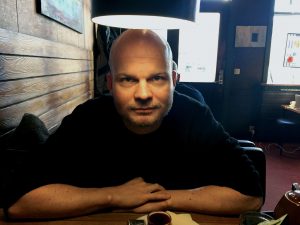
Filmmaker Grímur Hákonarson
HtN: (to Grímur) I’ve also been really impressed, in watching all these recent Icelandic films, with the performances of the actors. Is everyone that you cast a trained actor? Are any of them non-actors? And by the way, the villain in this new film looks a lot like the classic Hollywood actor Adolphe Menjou.
GH: Hmm. Interesting. The villain in The County is actually the main actor in Rams. But in Rams, he has a big beard, and now, he’s playing the bad guy
(everyone laughs)
HtN: Ah! Wow!
GH: I mean, I use amateurs for small, supporting roles, but for the leads, I always cast professional actors. I find it risky to cast amateurs for bigger roles. But in The County, there are a lot of farmers who live in the area, who have no experience, who did some kind of small parts, mainly just playing themselves. But, you know, even though Iceland is a small country, we have some good actors. Not so many, but…Sometimes as a director, there are maybe not so many possibilities, but we have people like Arndís, who can act.
HtN: Well, they’re all very good, and (to Arndís) I never would have believed that you’d never worked on a farm.
AHE: (laughs) Good to know.
GH: It is important to me to that the characters are always believable, and I put a lot of effort into making Inga believable as a farmer. We spent maybe the most time on that, I think?
AHE: Yeah. I think we did, yes, on the work.
ML: So, how accurate is this plot with the co-op, which you call a mafia? Does it exist? And if so, how have they reacted to the film?
(Grímur and Arndís laugh)
GH: Well, they won’t kill me. Iceland is a peaceful country. We don’t have any guns.
(everyone laughs)
GH: But it is based on a true story. There is this area in the northwest of Iceland, sometimes called the Icelandic Sicily. It’s like a very different area from the rest of Iceland, with the only remaining co-op in the country. There used to be this big cooperative movement, back in the day, but it only survived there. And after the film was released in Iceland, there was some kind of uprising there. The screenings were all sold out up there. Some people have been writing in the newspapers. There’s something going on, but I’m not sure it’s going to change anything.
ML: Normally, in films, I can kind of tell how it’s going to end, but this time, I was surprised by the direction you took.
GH: Well, the film is as much about grief as anything, and the ending is about Inga, more than the farmers. It’s open, what might happen afterwards. I like simplicity in storytelling, and I just wanted to stay with Inga.
AHE: I like the way that it ends.
HtN: It’s certainly a more hopeful ending than that of Rams.
(Arndís and Matthias laugh)
GH: A little bit. I’d say it’s a mixed ending. She wins a personal victory but loses the economic battle.
HtN: But she does make change. It’s a but of a pyrrhic victory, but also more than that. So, your country is so beautiful. I went there for the first time this past New Year’s, and was able to really see the natural landscape firsthand. It’s so beautiful that it’s so often a strong character, in and of itself, in Icelandic cinema. Do you ever find it a challenge, given the raw beauty of the country, to not let the landscape do the storytelling for you?
GH: My intention with The County was not to focus on the landscape, as I had in Rams, which is more about nature. My intention was to make it a bit dark and kind of dirty and to focus on this robotic milking barn and to show that the farmers are stuck in this kind of machine world. But the cinematographer was from Estonia, and he had never seen such nice landscapes, so he always wanted to shoot some mountains and … he just f***ed it up.
(everyone laughs)
ML: Why did you use a cinematographer from Estonia?
GH: We met in film school. We were in the same class at FAMU, the Czech film school, and we did some short films together, back in the day. We ran into some scheduling conflicts with the cinematographer who did Rams, so I called him, and he did it.
ML: About the landscape, I found the time of year interesting, with the areas of snow and no-snow and snow in the hills. That was a very aesthetic choice. Why this time of year?
GH: It was supposed to be a winter film, and I wanted to have a lot of snow and have it be very dark to get the feeling of isolation and of the hard life of Inga and her husband, but thanks to global warming, you know, there is no snow anymore, so you have to just play with that. It kind of looks like April or May.
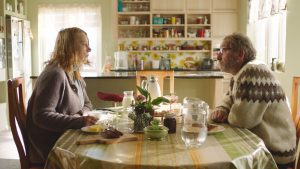
A still from “The County”
AHE: But it was in February.
ML: Really? I thought it was May.
GH: But it was cold; you could feel it. Sometimes it was minus 15 or so.
AHE: It was cold.
GH: And it gives this kind of blue look.
HtN: Of course, if you were to shoot in the dead of winter, say in December, you’d have very little light.
AHE: A very short time, yeah.
HtN: How much light did you have in February?
GH: When we started, we had maybe 8 hours.
HtN: OK. Not that bad. Going back to you, Arndís, what was the most challenging part of the film for you?
AHE: I think it was all the technical stuff. That is not something in my comfort zone and was very challenging for me. And also the birth of the calf. I felt incredibly responsible.
HtN: (laughs) I was going to ask about that!
(everyone laughs)
AHE: I felt so responsible, like I had the whole world on my shoulders. I was just so afraid he would die and that would be my fault.
HtN: And you’re pulling so hard! Is that really how you birth a calf? I assume that this must be what happens, but you pull so hard on his legs…
AHE: Most births are easy, for cows. I learned that. But sometimes, there’s a problematic birth, and then we have to pull. But it was incredible. I just cried afterwards.
HtN: Sure.
ML: Did you have to wait for a cow to be ready?
GH: Yeah! We had to just organize it around the cow. It’s a situation that you can’t control.
HtN: You! Give birth now!
(everyone laughs)
GH: Yeah! So, we had a cow like on standby, and we got a phone call, and she was giving birth. It was filmed like a documentary, since we couldn’t really control the situation. It was the only scene in the movie that was filmed in documentary style. But Arndís did a good job. We actually had to shoot it two times.
HtN: You mean with two different cows?
GH: Yes.
HtN: Well, it really sells the idea of Arndís – Inga – as a farmer, to open the film with that. It’s very smart, because from that point on I don’t question anything.
ML: As an actress in Iceland, do you also work in theater?
AHE: Yes. Since we are a small country, we don’t really specialize. You are not either a film actor or theater actor. You do everything: theater, radio, film. Of course, some of us do more theater and some more film. Not everyone has the opportunity to make films, but we have a national theater and a city theater. I’ve mostly done theater, but I’ve done two Icelandic television series, and I was in a movie called Sparrows, by Rúnar Rúnarsson.
ML: And people still go to the theater in Iceland?
AHE: Yeah. We are theater-goers. Of course, there’s always talk about how to make younger people go to the theater, but yeah, we still go.
HtN: And you have that beautiful theater in Reykjavík that I saw on my trip.
AHE: Yeah. That’s the national theater.
HtN: Who wouldn’t want to go there?
GH: The teenagers go to the cinema, and the old people go to the theater.
HtN: Well, thank you very much for chatting!
GH/AHE: Thanks!
– Christopher Llewellyn Reed (@ChrisReedFilm)








